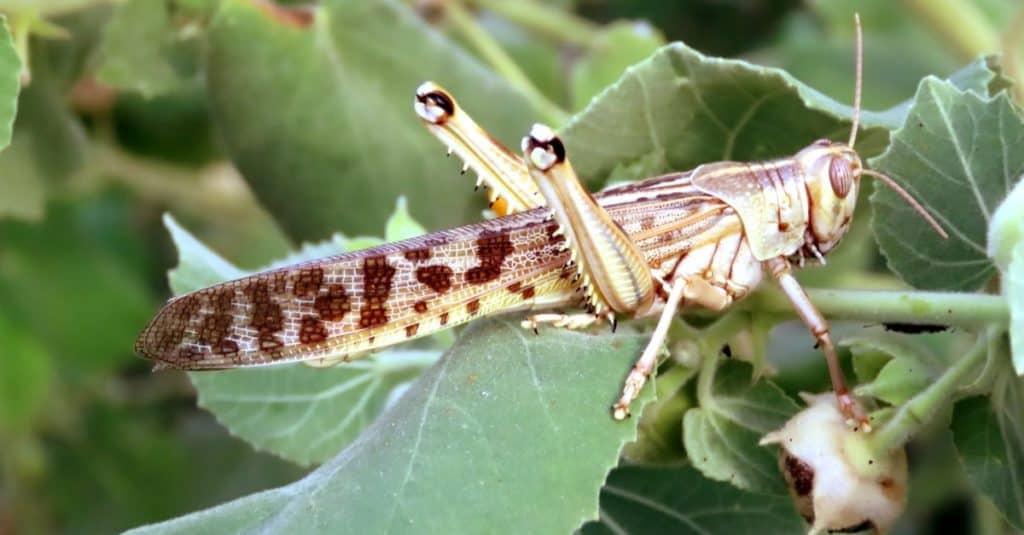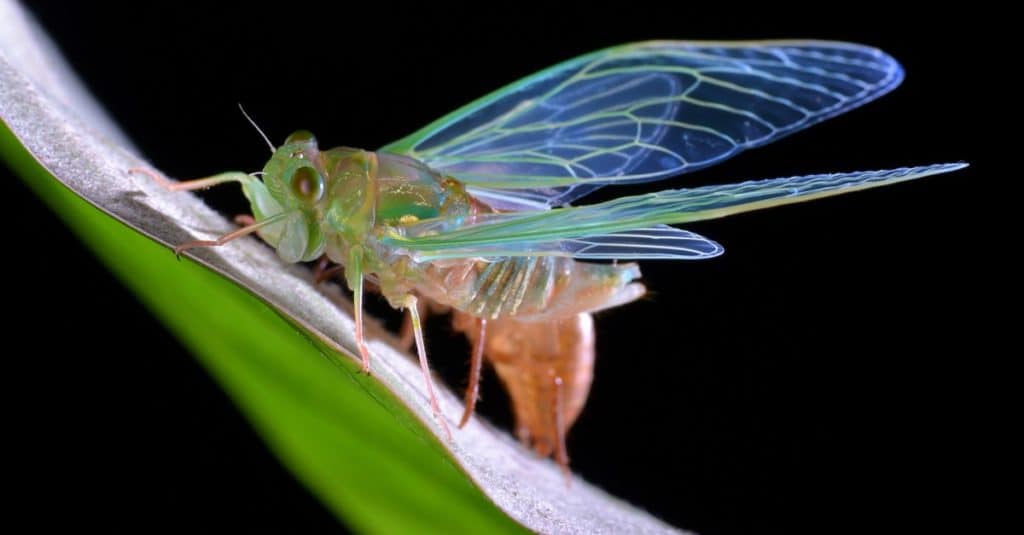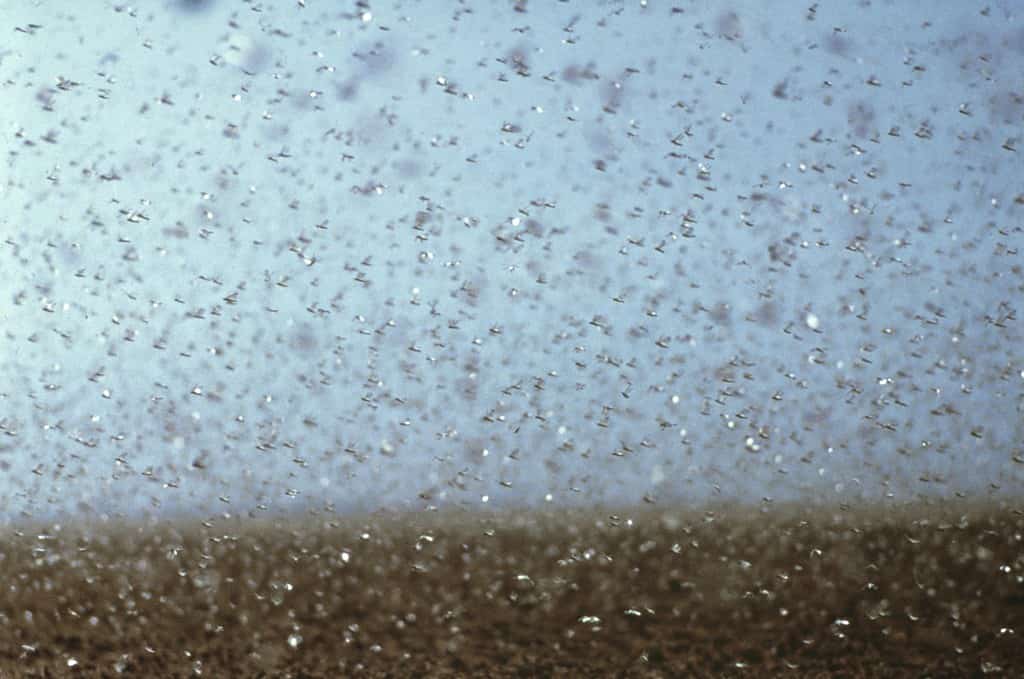With all the news stories about Cicadas and how Brood X is hatching in 2021, a lot of you probably have black, buzzing swarms of bugs on the brain! If you’re worried about Cicadas being like the plagues of Locust swarms you may have seen in movies, destroying crops and causing famine, don’t be! We’re going to take a look at the differences between the cicada vs locust to hopefully ease your troubled mind.
Are Locust vs Cicada the Same Thing?
Though they do share some similarities, and the names have been improperly used interchangeably almost since Cicadas were first discovered in North America, locust vs cicada are not the same!
If one looks at Locust vs Cicada: what’s the difference though? In simplified terms, a Cicada is more similar to an aphid, while a Locust is a type of short-horned grasshopper.
If you’re looking for more specifics, don’t worry!
We’re going to list many of the similarities and differences below between cicadas vs locusts, including what each insect’s basic life cycle is and what sort of sound each one makes.
The biggest difference between locusts vs cicadas is probably that, while they do emerge in very large numbers when they hatch, Cicadas do not swarm as Locusts do. Cicadas also do not decimate and consume crops in the same way as Locusts.
Locusts and Cicadas are both herbivores, but Cicadas are far less destructive when they feed. In fact, a lot of the damage Cicadas cause to plants comes from their egg-laying process, as opposed to their feeding habits. Locusts are both longer and thinner than Cicadas, with the long back legs common to all grasshoppers.
Cicadas have very small legs. Periodical Cicadas, the kind that only emerges from underground every 13-17 years, are only found in North America, where swarming Locusts have not been found since the Rocky Mountain Locust went extinct in 1902 and the High Plains Locust nearly so after a plague in 1930.
There are some similarities between these two insects. Both Cicadas and Locusts have wings, though Locusts tend to fly much greater distances. Both of these creatures eat plants and lay eggs. They are both very loud and usually appear in large groups. Neither locusts vs cicadas are aggressive toward humans, though it might feel that way if a large group of them is flying and you get in their way!
Let’s break down a few more of the differences and similarities between cicadas vs locusts in the following list.

Cicadas vs Locusts: what’s the difference? Here a Giant Locust is moving between the leaves of a plant.
©Ali Moussa/Shutterstock.com
Order
Cicada
Cicadas are a type of Hemiptera or “True Bug.” Some think they are related to crickets, but really they are not. Though they are much larger, Cicadas are similar to aphids, which are also in the Hemiptera order.
Locust
Locusts belong to the order Orthoptera. This order is divided into two suborders, with Locusts and grasshoppers on one side and crickets on the other.
Family
Cicada
Cicadas are in the family Cicadidae, which covers any bug that makes a sound, has prominent eyes, two membranous pairs of wings, and both compound and simple eyes.
Locust
Locusts are Acrididae. That family designation refers to any short-horned grasshoppers that migrate and swarm in great numbers.
Size
Cicada
Cicadas are typically about two inches long and half an inch across.
Locust
Locusts can reach up to four inches long, but some are less than half an inch in length!
Diet
Cicada
Cicadas drink the liquid from the inside of the stems, roots, and branches of plants.
Locust
Locusts eat the leaves and any of the softer segments of plants, which is why they are so destructive to crops when they swarm in plagues. They leave very little behind.

Cicadas vs Locusts: what’s the difference? Here one can see a newly emerged Cicada sitting on a branch.
©SIMON SHIM/Shutterstock.com
Lifespan
Cicada
The Cicada life cycle is very interesting. They lay their eggs on plants. When the eggs hatch, they become nymphs, which drop down to burrow into the ground where they live for most of their life. While underground, a Cicada nymph can live up to 17 years! Once they emerge, as Brood X did in 2021, they shed their outer shell and, once they lay more eggs, will die about six weeks after emergence.
Locust
Locusts have a much more mundane life cycle. They lay their eggs on the ground. Once they hatch, Locusts typically live between three to five months, but during that time they may lay as many as 1000 eggs!
Collective Name
Cicada
A group of Cicadas is known as a brood. In the United States, these broods have been given letter names according to their life cycle and which years they will hatch, such as Brood X, which hatched in 2021.
Locust
A large swarm of Locusts is called a plague.
Distinguishing Features
Cicada
Periodical Cicadas are most commonly black with bright red eyes, and the annual species have a very beautiful blue-green and black striped pattern. They are similar in size to an average human thumb. Their wings are a transparent yellow-orange color and extend beyond the end of their abdomens, protecting them from water and bacteria. The males use a pair of organs known as tymbals to make a very loud buzzing vibration that resonates through their mostly hollow bodies. The sound Cicadas make can reach up to 100 decibels!
Locust
Locusts are very similar in appearance to grasshoppers. They tend to be green before they go into their swarming phase, at which point their heads shrink and they change to brown and black or black with orange spots. They have two long, pointy antennae on the top of their heads and very long back legs which remain bent in half when they are at rest. They are much quieter insects, that make their sounds but rubbing two of their body parts together to create a buzzing or sometimes a snapping sound.
Which is the Most Feared by Humans?
While locusts and cicadas pose no physical threat to humans, one outranks the other as a threat to human crops. The appetite of a locust is voracious, and a plague of locusts about 1/3 of a square mile in size can consume food that would feed up to 35,000 people! The largest locust outbreak ever recorded took place between 2003 and 2005 in Africa, costing $2.5 billion in damaged crops. Because locust outbreaks are unpredictable, and the space of time between outbreaks can be years or decades, many countries don’t properly prepare to fight the plagues when they do occur, which can lead to complete devastation.
Whatever their differences, both Cicadas and Locusts are fascinating creatures!
Cicada Brood X News & Information
Brood X emerged in the spring of 2021 on the east coast of the United States. More information and coverage can be found here!
- Cicadas in New York: What’s Happening Now?
- Cicadas in Pennsylvania: What’s Happening Now?
- Cicadas in Virginia: What’s Happening Now?
- Cicadas in Tennessee: What’s Happening Now?
- Cicadas in Washington, DC: What’s Happening Now?
- Cicadas in Maryland: What’s Happening Now?
- Here’s What 1.5 Million Cicadas Looks Like
- Will Cicadas Cause More Snakes? Copperheads?
- Can Dogs Eat Cicadas?
- Will Cicadas Eat My Tomato Plants?
- Cicada Brood X 2021: What is it and should you be concerned?
- Why Do Cicadas Only Come Out Every 17 Years?
- Cicadas vs Locusts: What’s The Difference?
Do Locusts Still Exist?

Locust swarms then migrate across vast areas causing almost complete destruction to all green vegetation, especially agricultural crops.
Locusts can be found on almost every continent in the world, with the exception of Antarctica and North America, where they went extinct in 1902. They cause a remarkable amount of damage in these areas and in these three regions, Africa, Asia, and the Middle East, they can occupy a vast amount of area. When they are in their quiet phase, they can inhabit about 30 different countries, which comprise an area of about six million square miles.
There are about 27 species of locusts in the family Acrididae that cause damage to the land, and one species that causes significant damage is the desert locust. Once the desert locust emerges from its quiet phase, it threatens one-fifth of Earth’s land area and one-tenth of the global population during their swarm or plague. When these swarms descend upon a region they can spread out across some 60 countries which has a significant economic impact.
The photo featured at the top of this post is © Petr Ganaj/Shutterstock.com
Thank you for reading! Have some feedback for us? Contact the AZ Animals editorial team.







